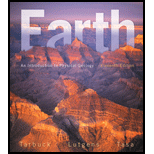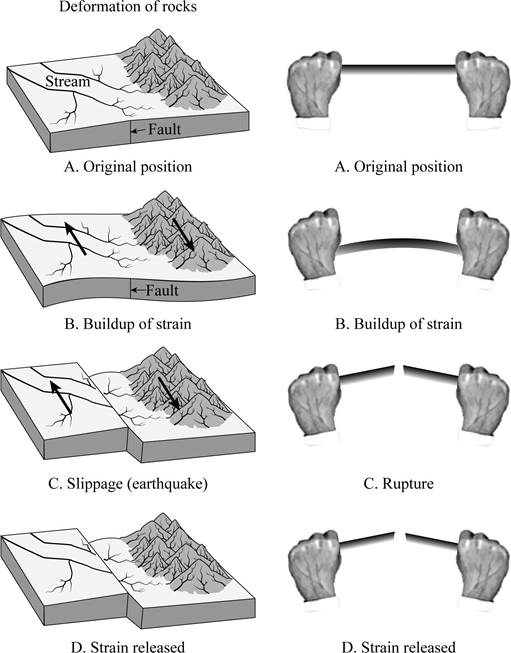
The concept of elastic-rebound theory with a sketch and an example to illustrate the concept (other than a rubber band).
Answer to Problem 1GST
The elastic-rebound theory explains how energy can be released during an earthquake, and an example other than a rubber band is a door attached with a spring. The following sketch illustrates the elastic rebound theory:

Explanation of Solution
Earthquakes occur due to the buildup of stresses; the stress acting on the walls of the faults make the rocks deform elastically till the faulting happens. Then, the deformed rocks try to retain their structure by a sudden vibration. This phenomenon is termed as elastic-rebound.
The other example that illustrates elastic-rebound is a door attached with a spring. When the door is open, the spring pulls the door back to its original position. Most strong earthquakes are produced due to the rapid release of elastic stress. As a result, the rocks will elastically retain their original shape.
Want to see more full solutions like this?
Chapter 11 Solutions
Earth: An Introduction to Physical Geology
- Figure 9.9 is a stereogram showing a portion of the area covered by the Whitewater, Wisconsin, topographic map (Figure 9.10, page 160). Use the stereogram and the map to complete the following. (I can only upload two images, so if you have figure 9.9 in Applications and Investigations in Earth Science 9th Edition it would help a lot) 1. After examining the map and stereogram, draw a line on the map to outline the area illustrated on the stereogram. 2. What evidence on the map indicates that portions of the area are poorly drained? On what part of the map are these features located? 3. Use Figure 9.11 to draw a topographic profile of the X-Y line on Figure 9.10. 4. Is the general topography of the land in Sections 7 and 8 in the northwest portion of the region higher or lower in elevation than the land around the letter A located near the center of the map? Is it more or less hilly? 5. Is the area that coincides with Kettle Moraine State Forest higher or lower in elevation than the…arrow_forwardFigure 9.9 is a stereogram showing a portion of the area covered by the Whitewater, Wisconsin, topographic map (Figure 9.10, page 160). Use the stereogram and the map to complete the following. 1. After examining the map and stereogram, draw a line on the map to outline the area illustrated on the stereogram. 2. What evidence on the map indicates that portions of the area are poorly drained? On what part of the map are these features located? 3. Use Figure 9.11 to draw a topographic profile of the X-Y line on Figure 9.10. 4. Is the general topography of the land in Sections 7 and 8 in the northwest portion of the region higher or lower in elevation than the land around the letter A located near the center of the map? Is it more or less hilly? 5. Is the area that coincides with Kettle Moraine State Forest higher or lower in elevation than the land to the northwest and southeast? 6. The feature labeled A on the map is a long ridge composed of till. Is this ridge an esker, an end moraine,…arrow_forwardLab 9: Oceans & Coastal Systems GEOG 1113L – Introduction to Landforms Lab Name: I. How the Coast Works 1. What area is considered the shore? (2 points) 2. Describe the type of area that is required for a beach to form. (4 points) 3. Beaches require constructive waves, which are defined as what? (2 points) 4. What is longshore drift? (3 points) 5. What is the difference between attrition and abrasion? (3 points) 6. What artificial barrier do humans use to protect the coast from high tide? (1 point) 7. What barrier is used to protect against longshore drift? (1 point) II. Coastal Systems This activity can be completed with the use of the USGSarrow_forward
- Low angle subduction of an ocean - continental convergent boundary can can lead toarrow_forward10 complete the map: chat All Bookmarks M Gmail YouTube 1. Select the given image below. It will open the link to a Google Doc. 2. Select FILE -> MAKE A COPY to make your own copy of the concept map. Please do not request edit access of the original document. for you. Please hold on while I c Image created 1 oxygen atom paste google drawing here. is neutral with Pure Water exists in three states on Earth changén state Major Properties high surface tension resulti is neutral 1 oxygen atom chian-tate 0 HH pH of exists in three esists in tiree here" As part of this tools You'll notice that in the bottom left the document says "paste google drawing Submit Cancel na e Consle drawing of a molecule of a types of atoms and the charges The concept map is now c Ask anything + Search B& Darrow_forwarddue today at 2pm, the problems have been done already, is there anyway you can draw the diagrams i was supposed to for each problem because I am confused on how to draw themarrow_forward
- due today at 2pm, the problem have been done already, is there anyway you can draw the diagrams i was supposed to for this because I am confused on how to draw themarrow_forwardTHIS IS DUE AT 2PM TODAY, I JUST NEED HELP WITH THE DRAWINGS THATS IT CAN SOMEONE PLEASE HELP MEarrow_forwardC) A thermometer D A seismometer 23 A student conducted an investigation to determine the effect of water temperature on the amount of sugar that dissolves in a beaker of water. Identify components for trial 1 of this investigation. DRAG & DROP THE ANSWER Note: Use CTRL+D to drag the option via keyboard Constant DV IV Trial 1 Beaker Number Amount of Temperature of Temperature of Amount of Suga Water (mL) Sugar (°C) Water (°C) Dissolved (g) 1 100 20 5 185 2 100 20 10 189 20 15 194 204arrow_forward
- due today at 2pm, the problem have been done already, is there anyway you can draw the diagrams i was supposed to for this because I am confused on how to draw themarrow_forward1. Calculate the elevation of the water table at each well location and write the approximate elevation on the line next to each well. Next, use a colored pencil to draw smooth 10-foot contours that show the shape of the water table. (Start with the 1160-foot contour.) Use a pencil of a different color to draw arrows on the map to indicate the direction of the slope of the water table. a. Toward which direction (downward) does the water table slope? b. Referring to the site of the proposed water well, at approximately what depth below the surface should the proposed well intersect the water table? 2. Assume that a dye was put into well A on May 10, 2017, and detected in well B on May 25, 2018. What was the rate of groundwater movement between the two wells, in centimeters per day? (Hint: Convert feet to centimeters.)Velocity:_____________centimeters per dayarrow_forwardPART 1 Activity 8.7 Ground Subsidence (Figure 8.7) 1. What is the general relationship between ground subsidence and the level of water in the well? 2. What was the total ground subsidence, and what was the total drop in the level of water in the well during the period shown on the graph?Total ground subsidence: —--feetTotal drop in well level: —-- feet 3. During the period shown on the graph, on aver-age, about how much land subsidence occurred with each 20-foot decrease in the water level in the well: 1 foot, 5 feet, or 10 feet?Subsidence: about—----foot/feet 4. Was the ground subsidence that occurred between 1930 and 1950 less or more than the subsidence that occurred between 1950 and 1970?Ground subsidence from 1930 to 1950 was—----than that from 1950 to 1970. 5. Notice that minimal subsidence occurred from 1935 to 1950. Refer to the well water level during the same period of time and suggest a possible reason for the reduced rate of subsidence. PART 2 Activity 8.8 Examining a…arrow_forward
 Applications and Investigations in Earth Science ...Earth ScienceISBN:9780134746241Author:Edward J. Tarbuck, Frederick K. Lutgens, Dennis G. TasaPublisher:PEARSON
Applications and Investigations in Earth Science ...Earth ScienceISBN:9780134746241Author:Edward J. Tarbuck, Frederick K. Lutgens, Dennis G. TasaPublisher:PEARSON Exercises for Weather & Climate (9th Edition)Earth ScienceISBN:9780134041360Author:Greg CarbonePublisher:PEARSON
Exercises for Weather & Climate (9th Edition)Earth ScienceISBN:9780134041360Author:Greg CarbonePublisher:PEARSON Environmental ScienceEarth ScienceISBN:9781260153125Author:William P Cunningham Prof., Mary Ann Cunningham ProfessorPublisher:McGraw-Hill Education
Environmental ScienceEarth ScienceISBN:9781260153125Author:William P Cunningham Prof., Mary Ann Cunningham ProfessorPublisher:McGraw-Hill Education Earth Science (15th Edition)Earth ScienceISBN:9780134543536Author:Edward J. Tarbuck, Frederick K. Lutgens, Dennis G. TasaPublisher:PEARSON
Earth Science (15th Edition)Earth ScienceISBN:9780134543536Author:Edward J. Tarbuck, Frederick K. Lutgens, Dennis G. TasaPublisher:PEARSON Environmental Science (MindTap Course List)Earth ScienceISBN:9781337569613Author:G. Tyler Miller, Scott SpoolmanPublisher:Cengage Learning
Environmental Science (MindTap Course List)Earth ScienceISBN:9781337569613Author:G. Tyler Miller, Scott SpoolmanPublisher:Cengage Learning Physical GeologyEarth ScienceISBN:9781259916823Author:Plummer, Charles C., CARLSON, Diane H., Hammersley, LisaPublisher:Mcgraw-hill Education,
Physical GeologyEarth ScienceISBN:9781259916823Author:Plummer, Charles C., CARLSON, Diane H., Hammersley, LisaPublisher:Mcgraw-hill Education,





